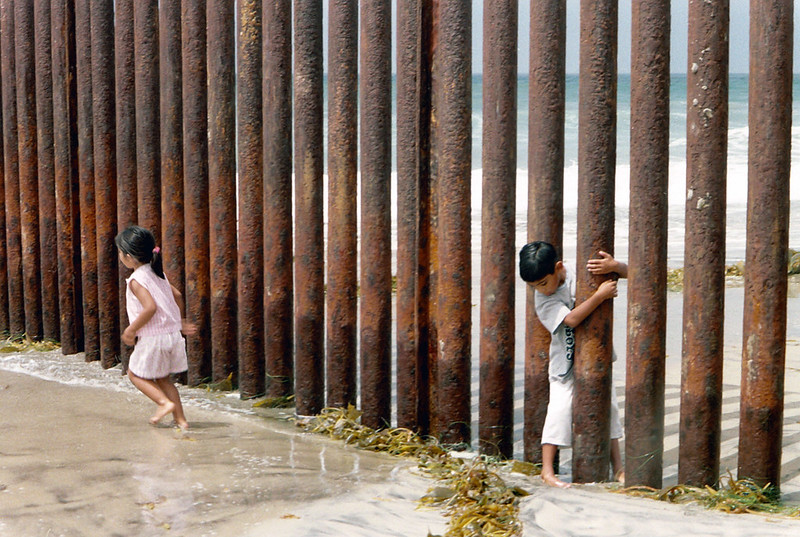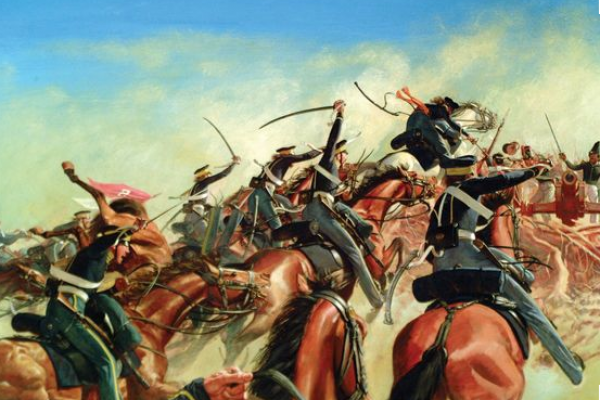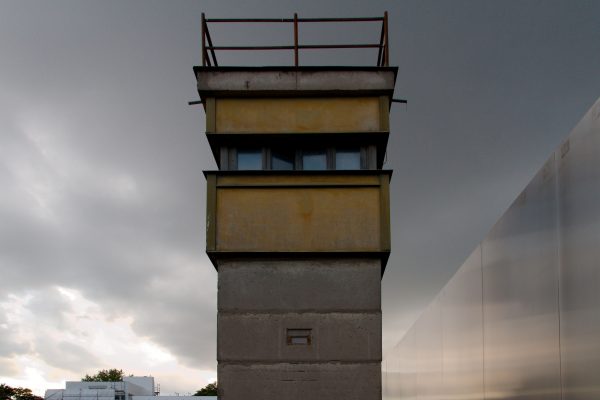I grew up on the short story “Toba Tek Singh,” an Urdu satire on the Partition. While the story’s protagonist is a Sikh man, for whom the story is named, the character that stuck with me most was an unnamed man in a mental health facility in Lahore. Refusing to take part in the partitioning of patients between India and Pakistan, he climbed onto a tree and proclaimed, “I do not want to live in either India or Pakistan. I am going to make my home here in this tree.”
The Partition—the scars of which reverberate today in brahiminical Hindutva fascism, the genocidal Indian occupation of Kashmir, mass protests of debt-ridden farmers, and counterinsurgency in Panjab—displaced at least 15 million people and killed at least one million across the newly drawn borders. My grandfather’s own family was displaced from their village, after which he started working the passenger and cargo trains that transported up to 5,000 refugees a day. He later recounted stories of torture, kidnappings, burnings, rapes, and massacres. In the afterlife of this carnage, I found the seemingly mad man on the tree marvelously rebellious and utterly lucid.
To be a modern nation-state in a state-centric world presupposes the necessity of a secured border. Radhika Mongia argues, “Today all states embody a historically produced colonial dimension, with the citizen/migrant distinction as one of the primary axes of such differentiation.” Borders maintain hoarded concentrations of wealth accrued from colonial domination while ensuring mobility for some and containment for most—a system of global apartheid determining who can live where and under what conditions. The Indian Border Security Force is the world’s largest border security force, Europe’s Mediterranean border is the world’s deadliest border, and Australia jails detainees for an average of 689 days in its matrix of offshore immigration detention centers. As Toni Morrison described in her prophetic 1997 work, “Home,” “The contemporary world’s work has become policing, halting, forming policy regarding, and trying to administer the movement of people. Nationhood—the very definition of citizenship—is constantly being demarcated and redemarcated in response to exiles, refugees, Gastarbeiter, immigrants, migrations, the displaced, the fleeing, and the besieged.”
We are witnesses to the horrific impacts of this categorization and control of people. Suffocation in the back of cargo trucks in Texas and Arizona, dehydration in blistering heat in the Horn of Africa’s eastern corridor, unmarked graves in the Sonoran and Sahara deserts, deadly pushbacks of migrant caravans in Melilla and Croatia, and wet cemeteries throughout the Mediterranean are the deathscapes of borders’ victims.
As the (always racialized) body count grows, language such as “border crisis” becomes a pretext for more border securitization, including repressive practices of interdiction and the criminalization of smuggling. Migrants and refugees become the cause of an imagined crisis at the border, despite the fact that approximately 95 percent of displaced people remain internally displaced or in refugee camps. In fact, mass displacement and immobility represent the outcome of the actual displacement crises of capitalism, conquest, and climate change. The catastrophic effects of climate disasters, which displace one person every two seconds, are a primary source of escalating border militarization in our era. While ruling elites fail to mitigate climate change, “climate security” is the latest screed of eco-apartheid proponents. “Borders are the environment’s greatest ally; it is through them that we will save the planet,” declares the party of French far-right politician Marine Le Pen. Meanwhile, the Australian Defense Forces have announced military patrols to intercept climate migrants, and the United States has created Homeland Security Task Force Southeast to enforce marine interdiction and deportation after climate disasters in the Caribbean.
In addition to the nascent scapegoat of the “climate migrant,” the border merges a range of other constructed threats. There is the illegal (bear in mind: Crees, Chippewas, and Yaquis launched political battles for Indigenous tribal recognition after being considered illegal immigrants); the terrorist (never forget: 779 Muslim men and boys were imprisoned and tortured at Guantánamo Bay); the criminal (remember: Clinton’s 1996 immigration laws dramatically widened the net for detention and deportation for those with convictions); the bogus refugee (recall: most refugees from Vietnam were welcomed during the Cold War, while most Haitians fleeing U.S. destabilization were deemed bogus and faced detention and deportation); the swarm (Trump infamously propagandized: “Working-class Americans are left to pay the price for mass illegal immigration: reduced jobs, lower wages, overburdened schools, hospitals that are so crowded you can’t get in, increased crime, and a depleted social safety net”); the undeserving (Obama peddled: “Felons, not families. Criminals, not children. Gang members, not a mom who’s working hard to provide for her kids”); the diseased (still counting: 1.7 million Title 42 expulsions from the U.S. during the pandemic); the foreigner (compare to: “We’re talking about Europeans [Ukranians] leaving in cars that look like ours to save their lives”).
The mass production and social organization of difference is at the heart of border-craft. Bordering regimes, as Wendy Brown asserts, “do not simply respond to existing nationalism or racism. Rather, they activate and mobilize them.” Borders control through selective inclusions and expulsions, making and maintaining the “good versus bad” migrant, as well as the colonial, racial, gendered, sexualized, ableist, and class-based hierarchies among legal citizens. Today, as white nationalist, anti-trans, and xenophobic fascism swells, the border has become a central site of struggle.
all around, and creeping
self righteous, let’s say it, fascism,
how else to say, border—Dionne Brand, from “Inventory”
Borders are not fixed lines demarcating territory. They are elastic; bordering regimes can be enforced anywhere. Subjected to surveillance and disciplinary mechanisms within the nation-state, undocumented migrants endure the omnipresent threat of immigration enforcement, dangerous and low-wage work, and barriers to accessing public services. The production and policing of the border becomes a quotidian workplace ritual as law enforcement, doctors, teachers, landlords, and social workers regularly report migrants to border agencies.
Borders can thus follow people indefinitely. Moreover, as employers and elite leaders intend, the making of “illegal workers” acts as a firewall (or border) blocking solidarity between workers. In Saudi Arabia, for instance, simmering working-class dissent over rising unemployment and shrinking state programs is being redirected into xenophobic propaganda, which calls for the Saudization of the workforce and immigration enforcement. In 2017 the Saudi monarchy arrested a staggering 2.1 million migrants, mostly from Yemen and Ethiopia.
Bordering regimes are also increasingly layered with controls far beyond nation-states’ territorial limits. The United States, Australia, and Europe subordinate Central America, Oceania, Africa, and the Middle East by compelling countries in these regions to accept border checkpoints, drone surveillance, offshore detention, and migration prevention and interception campaigns as conditions of trade and aid agreements. Nauru, formally under Australian administration and United Nations trusteeship until 1968 and devastated through centuries of resource colonialism, is now Australia’s dumping ground for refugees. When Australia started offshoring refugee detention there over twenty years ago, its increased aid to Nauru represented a third of the country’s GDP. Nauru, Libya, Mali, Mexico, Niger, Papua New Guinea, Rwanda, Turkey, and Sudan are becoming the new frontiers of border militarization. Similarly, Croatia, Ukraine, and Moldova—in joining or aspiring to join the EU—must participate in EU border management missions and partnerships.
This essay is featured in Imagining Global Futures.
The outsourcing of border controls for migration management globalizes border violence and maintains a colonial present. For example, a century-long line of dirty coups and trade agreements has created displacement and migration from Mexico and Central America to the United States. Today U.S. initiatives that outsource border violence to these countries help to extend the nineteenth-century Monroe Doctrine, which established the United States’ imperialist claim on Mexico as well as South and Central America. Initiated by President Bush and expanded under Presidents Obama and Biden, the multibillion-dollar U.S.-Mexico Mérida Initiative provides funding for a battery of police and migration checkpoints from southern Chiapas to the U.S. border. Mérida and its counterpart, the Central American Regional Security Initiative, paramilitarize the entire landscape through the triad of the war on drugs, the war on Indigenous lands, and the war on migrants. The United States also funds immigration enforcement in El Salvador, Guatemala, Honduras, and Mexico. Shortly after the United States launched the Mexico-Guatemala-Belize Border Region Program, Homeland Security officials declared that “the Guatemalan border with Chiapas is now our southern border.” Writing on the U.S. empire of borders, Todd Miller remarks, “Close your eyes and point to any landmass on a world map, and your finger will probably find a country that is building up its borders in some way with Washington’s assistance.”
Europe also outsources border controls to many African countries in the Sahel region, maintaining colonialism’s civilizational myth. The Khartoum Process, Valletta Summit, Migration Partnership Framework, African Peace Facility program, and EU Emergency Trust Fund for Africa all promise EU development and aid in exchange for reducing African migration into Europe. The EU also directly funds anti-migrant surveillance, military equipment, detention centers, border enforcement trainings, and troops in Tunisia, Niger, Libya, Mali, Mauritania, Rwanda, and Sudan. As former Italian Interior Minister Marco Minniti put it, “Securing Libya’s southern border means securing Europe’s southern border.” The massive scale of ongoing imperialist European land grabbing, resource extraction, and military expansion on the African continent exists alongside the enforced expansion of border enforcement within Africa to serve Fortress Europe. A coalition of African civil society organizations describe these murderous practices as “hunting policies for migrants that grow everywhere on the African continent with the support of the European institutions under the guise of the fight against ‘irregular’ migration.”
But border enforcement is not only the terror of outright exclusion and expulsion. In the mid-1800s, militias at the U.S.-Mexico border, made up of slaveowners, patrolled the border to keep Black people within the nation-state and to prevent them from escaping to Mexico. As Robyn Maynard stresses, the “devaluation of Black life and labour under slavery” underwrites “Jim-Crow style” exploitative labor migration into the United States and Canada. After its formal inception in 1924 until World War II, the U.S. Border Patrol was overseen by the Department of Labor. Borders are not intended to exclude or deport all people but to create conditions of deportability, which produces immense precarity for labor. The border captures workers’ labor power for employers to exploit. Workers are kept compliant through threats of termination and deportation. According to one U.S. study from 2012, 52 percent of companies undergoing union drives threaten to call immigration authorities. In 2019 ICE raided the Peco and Koch processing plants in Mississippi shortly after a high-profile unionization drive and detained 680 workers. Workers are declared illegal, but the surplus value they create is not.
Even state-sanctioned, temporary migrant workers are central to state formation, citizenship regulation, labor segmentation, and segregated social ordering. In Gulf Cooperation Council countries, migrant workers represent a whopping 66 percent of the total labor force. Capitalism requires the constant segmentation of labor, and the border offers it a “spatial fix” by bifurcating the global labor force. Adam Hanieh remarks, “We need to situate migration as an internal feature of how capitalism actually functions at the global scale—a movement of people that is relentlessly generated by the movement of capital, and which, in turn, is constitutive of the concrete forms of capitalism itself.” Around the world contemporary Bracero programs represent an extreme neoliberalization of both immigration and labor policies. Withholding full immigration status and tying visa status to an employer creates pools of cheapened, indentured laborers. These legal-but-deportable workers are often spatially and socially segregated: housed in separate labor camps, unprotected by national labor laws or unions, refused access to public services, and unable to bring their families with them.
Labor migration shapes the state to manage citizenship and sustains capital’s ability to coerce labor. The designation of “foreign workers” creates a material and ideological differentiation that further affixes race to citizenship. “Foreign workers” is essentially a euphemism for “Third World” workers, and jobs that cannot be outsourced to the periphery—such as farm work and domestic work—are thus insourced through migrant work. Even where migrant workers enter the same national labor market as citizens, or work for the same corporate employer transnationally, the border enforces wage differentiation based on race, citizenship, and gender. Insourced labor (from labor migration programs) and outsourced labor (in free trade zones) thus represent two sides of the same coin: deliberately deflated labor and political power.
Finally, borders rely on and reproduce the idea of a homogeneous body politic, emphasizing difference not only from those migrants deemed deviant and undesirable but also from those alienated and minoritized citizens who are essentially stateless within the nation-state. From the sweatshop floor and the refugee camp to the reservation and the gated community, borders are the scaffolding for ordering regimes that simultaneously manufacture and discipline surplus populations while parasitically extracting land, labor, and life itself. Classifications such as “migrant” or “refugee” do not represent social groups as much as they symbolize state-regulated relations of difference and state-manufactured conditions of vulnerability. While the rich from wealthy states enjoy borderless mobility—as global investors, bankers, expats, or hipster tourists—racialized poor people are subjected to discursive and material criminalization and illegalization.
Borders are simultaneously monetized and militarized. Racial capitalism and racial citizenship rely on the dispossession and immobility of migrants to maintain state power and capitalist extractions. Like the carceral construct of criminality, illegality is invented and policed as a race-making and property-protecting regime. And—like policing, prisons, and private property—borders destroy communal social organization by operating through the logic of dispossession, capture, containment, and immobility. As Angela Davis and Gina Dent write, “We continue to find that the prison is itself a border.”
Borders thus shape and are shaped by social relations. The border reproduces a global colonial racial social order that fortifies the rich against the rest, deflates labor power, treats sacred land as a possession, and provides the ideological basis for all repressive immigration enforcement. “Border crises,” then, are not merely domestic issues to be managed through tweaking immigration policies. They reflect a crisis of globalized asymmetries of capital and power—inscribed by race, caste, class, gender, sexuality, ability, and citizenship—that create migration and constrict mobility. The border is a tool of imperial management, labor segmentation, and social ordering that is both domestic and global. For example, it operates unambiguously in the deployment of the U.S. Border Patrol Tactical Units not only at the border, but in Iraq and Guatemala where they train local forces, and in Portland where they repress Black uprisings.
In BlackLife: Post-BLM and the Struggle for Freedom (2019), Rinaldo Walcott and Idil Abdillahi emphasize that the politics of migration is embedded in anti-Black racial logics. “Movements that we now call migration are founded in anti-blackness, taking their logic from transatlantic slavery,” they write. The sustained capture and punishment of Black mobility, the racialization of Muslim people dating back to the Reconquista, the genocidal corralling of Indigenous peoples onto reservations, the violent transformation of noncapitalist land stewardship into the regime of private property, the dispossession and proletarianization of millions into caste-oppressed indentured labor, and the deliberate cleaving and creation of “post-colonial” nation-states are all constitutive of the global policing of migration today. Declaring the migration crisis as a new crisis for Western countries is offensive: it conveniently erases the violence of capitalism, colonialism, genocide, slavery, and indentureship—the interlocking unfreedoms that create the conditions that make the border possible. The liberal nation-state is not a victim; it has aborted the dream of genuine decolonization and liberation by providing a territorial and jurisdictional grounding for capital and becoming the most legible form of coercive state power.
This is the year that those
who swim the border’s undertow
and shiver in boxcars
are greeted with trumpets and drums—Martín Espada, from “Imagine the Angels of Bread”
If borders of nation-states are designed to cement structural inequities through porous segmentation and ordering, can they ever become an anti-colonial architecture? Just as police and prisons will never serve the interests of survivors of racial, gendered, or transphobic violence, borders are not a method of safety or self-determination. As Adom Getachew suggests in Worldmaking after Empire (2019), we can look to Black nationalist struggles against colonialism: they did not envision decolonization as the globalization of the nation-state into the capitalist economy and international hierarchy but rather proposed to reconstruct the world through internationalism and redistribution. We might follow their lead when considering how our modes of worldmaking and homemaking could be organized differently. William C. Anderson offers a meditation in this regard: “We are fighting for an existence where there are no states to deport, dispossess, murder, detain, imprison, pollute, and police us on behalf of the ruling elite of the world.”
While liberals who argue for more humane immigration policies presuppose a “natural” border, Nicholas De Genova suggests, “If there were no borders, there would be no migration—only mobility.” In other words, while open borders might mean freer movement across nations in a world otherwise still configured under the status quo, to abolish the border would mean emancipating ourselves from all the unfreedoms it upholds. Migrante International, a global network of Filipinx people in over two dozen countries, advocates against the “plunder of economies, destruction of the environment and wars of aggression that cause widespread poverty and injustice” in the Philippines, and also for “migrants’ rights and dignity against all forms of discrimination, exploitation and abuse in the workplace and in the community.” Abolishing borders can secure these propositions: the freedom to stay, meaning that no one is forcibly displaced from their homes and lands, and the freedom to move with safety and dignity. A world without borders is necessary if we are serious about ending the ravages of imperialism, the violent extraction of capitalism, and the oppressive racial social organization of our world. Following Eduardo Galeano’s invocation, “The world was born yearning to be a home for everyone,” a world without borders is a world where everyone can find, make, and belong at home.
While a world without borders certainly requires us to stretch our futurist imaginations, it is also already here in present-day, practical politics. Movements that call for the abolition of border enforcement agencies, border controls, deportations, and the criminalization of migration offer prefigurative visions of the future, as do those that advance granting immigration status, labor protections, and universal public services for all. The Manifesto of the Sans-Papiers movement in France states: “We demand papers so that we no longer suffer the humiliation of controls based on our skin, detentions, deportations, the break-up of our families, the constant fear.” And in Australia RISE: Refugees, Survivors and Ex-Detainees demands housing, healthcare, language services, education, work rights, legal aid, and freedom of movement for all asylum seekers. While these and other movements may demand that the state offer material relief, these struggles ultimately aim to render the border obsolete.
Radical articulations such as “No human being is illegal,” “No borders on stolen land,” and “We didn’t cross the border, the border crossed us” refuse the rights-based, liberal platitudes of innocence, desirability, and assimilation and challenge the legitimacy of the border itself as an institution of governance. Many movements also highlight how migration is an embodied expression of decolonial reparations and redistribution, thus revealing a convergence of migrant and global justice movements (against the arms trade, vaccine apartheid, unfair trade agreements, debt, climate change, and so on). Les Gilets Noirs, a collective of mostly African undocumented migrants in France, assert their presence as an accounting for the exploitation that is a precondition for Europe. They boldly pronounce: “We are the freedom to move, to settle down to act. We will take it as our right.” In Canada the proclamation “No One Is Illegal, Canada is Illegal” highlights the hypocrisy of the settler-colonial state positioning itself as an arbiter of immigration. The Red Nation compellingly articulates “We have an Indigenous-centered perspective of migrant justice and organizing that rejects the settler state’s notions of citizenship and instead creates solidarity between Indigenous people and undocumented migrants. . . . We demand the abolition of all borders from Palestine to Turtle Island.”
On Indigenous Wet’suwet’en land, elders and matriarchs exercise alternative conceptions of governance rooted in their laws. Everyone entering their lands is asked: What is your intention? How will your visit benefit the community? Are you here on behalf of industry or the government? These questions are fundamentally about consent and an explicit counterforce to the logics of carceral, colonial, and capitalist states. They remind us that our responsibilities to one another and all living beings are actively negotiated and can and must be de-propertied, de-carceral, demilitarized, and decolonial. A liberatory, no-borders politics destabilizes the machinery of the colonial-capitalist state itself.
“No borders” is also a clarion call for the established left, specifically the environmental movement and major labor unions. State formation, class relations, extractivism, and social hierarchies are generated through each other. The conditioning of environmental movements and class struggles through citizenship reinforces the logic of scarcity upon which austerity and carceral governance depends, maintains the international division of labor and a lowered wage floor upon which capitalism relies, and aligns with far-right racism and ruling-class extractavist ideology. More specifically, environmental movements advocating for conservation, biocarbon sequestration, biofuel production, and alternative energies are often complicit in greenwashed colonialism. Even more progressive proposals such as the Green New Deal have become trapped in imperialist imaginaries of rich countries as white sanctuaries and gated communities. In a similar vein, unions that call for border enforcement against migrant workers in the interests of “citizen workers” (itself a problematic term) misunderstand the role of the border and capital. The border cannot protect the working class against neoliberal globalization because immobilized labor generated by the border serves the interests of free capital. Racial capitalism and racial citizenship require bordered labor.
Migrant workers do not cause environmental degradation or suppress wages; bosses, corporations, and borders do. An internationalist, feminist, abolitionist, labor rights platform is perhaps best articulated by migrant sex workers enduring the intersection of sex work criminalization, precarious migration status, and gendered labor—all of which, not coincidentally, uphold the feminization of poverty. Canary Song, a coalition of migrant Asian and Asian American sex workers in the United States, articulates a vision against policing, deportation, and anti-trafficking raids, while advancing labor rights for all sex workers and migrant workers to “openly assemble without fear, share resources, and collectively organize for better wages and working conditions.”
Abolition, Ruth Wilson Gilmore teaches us, is concerned with collective presence and building life-affirming institutions. Hundreds of campaigns are fighting for solidarity/sanctuary cities, where undocumented residents are guaranteed access to public needs and local jurisdictions limit cooperation with federal immigration agents. Dozens of civilian solidarity/rescue missions on land and on sea are engaged in lifesaving, and often illegal, efforts to provide food, water, shelter, and transportation to migrants and refugees. There are many ways people and organizations are extending networks of collective care and safety: people opening their homes to refugees, congregations of faith sheltering migrant fugitives, people distributing food and medical supplies at border sites such as Calais and Nogales, houseless and stateless squats and encampments, migrant workers and labor unions uniting to establish rank-and-file worker centers, direct actions preventing immigration raids, and internationalist organizing. These actions create liberated zones of belonging beyond and against neoliberal, nationalist conceits. These ecosystems, even if small in scale, model different forms of social relations, solidarity, and kinship through the process of joint struggle.
And the everyday unsanctioned movement of people—defying borders and risking death—is, in itself, worldmaking and homemaking. Without romanticizing or generalizing the politics of those on the move, we must recognize the sheer will and productive power they represent. In their determination for a different life, migrants and refugees subvert the multibillion-dollar global industry of barbed wire walls, drone surveillance, militarized checkpoints, and bureaucratic violence aimed at fatally deterring them. Revolutions bring no guarantees, but they do call on us to dream, listen, commune, act, struggle, dismantle, rematriate, create, to move and make anew.









